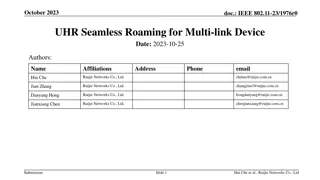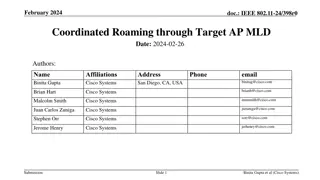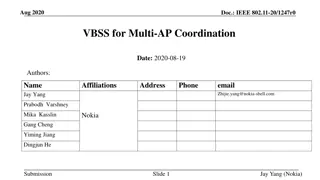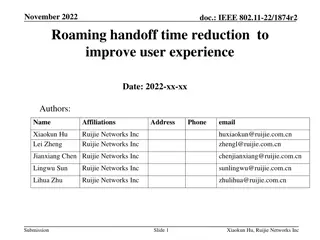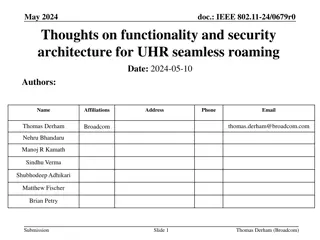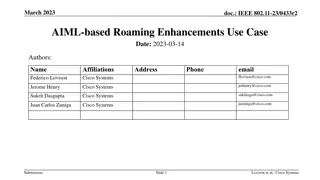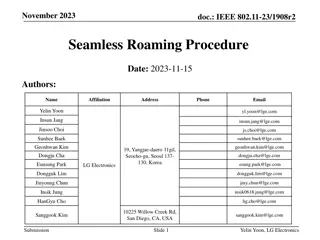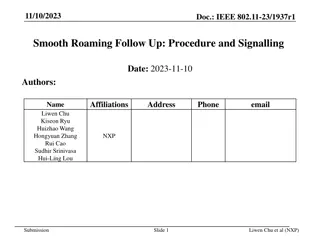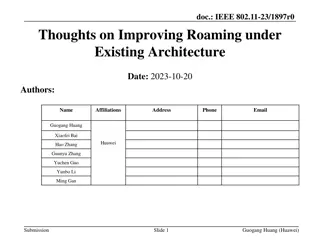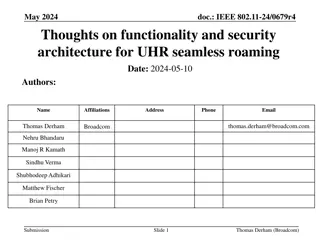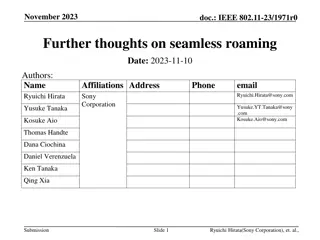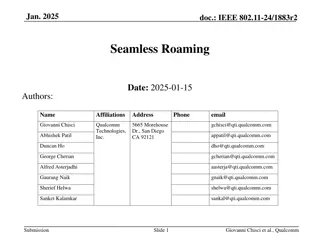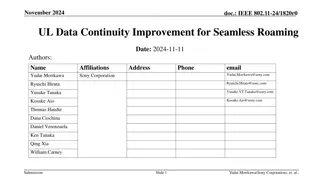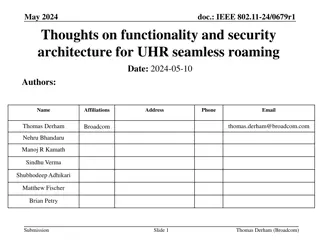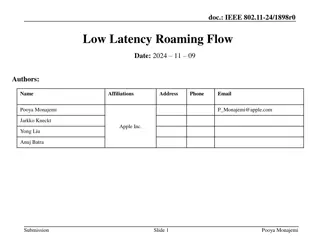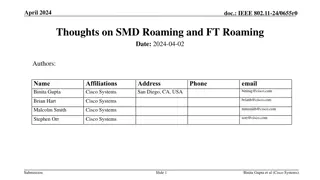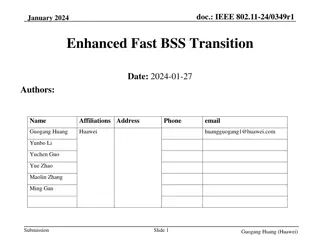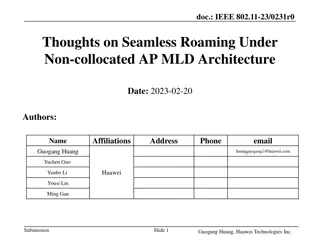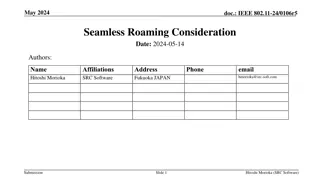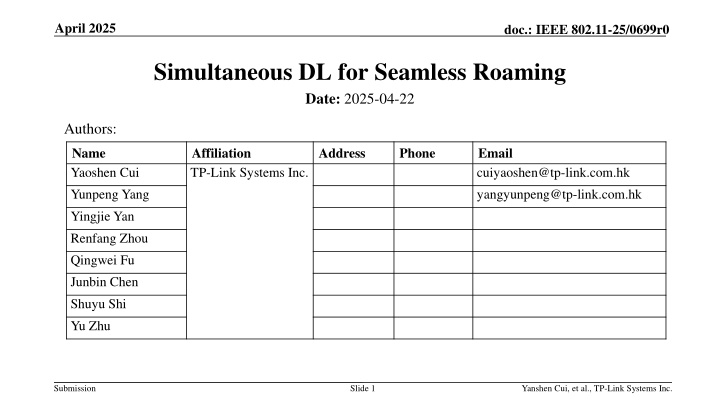
Seamless DL Schemes for Reliable Roaming in IEEE 802.11 Networks
Explore the implementation of simultaneous DL schemes for seamless roaming in IEEE 802.11 networks, focusing on enhanced reliability and performance using multi-link operations. Analyze the benefits of simultaneous DL in the same TID and different TIDs, optimizing data transmission efficiency during roaming procedures.
Download Presentation

Please find below an Image/Link to download the presentation.
The content on the website is provided AS IS for your information and personal use only. It may not be sold, licensed, or shared on other websites without obtaining consent from the author. If you encounter any issues during the download, it is possible that the publisher has removed the file from their server.
You are allowed to download the files provided on this website for personal or commercial use, subject to the condition that they are used lawfully. All files are the property of their respective owners.
The content on the website is provided AS IS for your information and personal use only. It may not be sold, licensed, or shared on other websites without obtaining consent from the author.
E N D
Presentation Transcript
April 2025 doc.: IEEE 802.11-25/0699r0 Simultaneous DL for Seamless Roaming Date: 2025-04-22 Authors: Name Yaoshen Cui Yunpeng Yang Yingjie Yan Renfang Zhou Qingwei Fu Junbin Chen Shuyu Shi Yu Zhu Affiliation TP-Link Systems Inc. Address Phone Email cuiyaoshen@tp-link.com.hk yangyunpeng@tp-link.com.hk Submission Slide 1 Yanshen Cui, et al., TP-Link Systems Inc.
April 2025 doc.: IEEE 802.11-25/0699r0 Introduction TGbn has agreed several schemes to improve reliability of seamless roaming, such as buffered data retrieving after roaming response and DL data forwarding between AP MLDs within same SMD[1]. When performing multi link operation, non-AP MLD is able to exchange DL data with target AP MLD via different link during the period for retrieving buffered data from current AP MLD. Thus, the two AP MLDs can simultaneously transmit DL data to non-AP MLD. The DL data transmitted by both AP MLDs may belong to same TID or only different TIDs. Simultaneous DL in same TID should consider the restraint of receive window for that newest data from target AP MLD may impede buffered data from current AP MLD. In this presentation, we analysis the simultaneous DL schemes in same TID and in different TIDs during seamless roaming. Submission Slide 2 Yanshen Cui, et al., TP-Link Systems Inc.
April 2025 doc.: IEEE 802.11-25/0699r0 Seamless Roaming Under Multi Link Operation Under single link operation, target AP MLD can transmit DL data to non-AP MLD only after current AP stops its transmission. Additional latency or packet loss may occur during the switch interval. When performing multi link operation, target AP MLD can transmit DL data to non-AP MLD via different link during the period for retrieving buffered data from current AP MLD. The simultaneous DL of two AP MLDs can improve performance on reliability or latency. Single link operation Multi link operation Submission Slide 3 Yanshen Cui, et al., TP-Link Systems Inc.
April 2025 doc.: IEEE 802.11-25/0699r0 Simultaneous DL in Same TID (1/2) The BA operation in MLO specified in 11be supports simultaneous transmission of the same TID via different links to improve transmission efficiency. H v , d , d z O B -collocated APs for that there is no real- time BA sync between current AP MLD and target AP MLD. Even though, simultaneous DL in same TID can be used to improve reliability during roaming similar to the DAPS realization in 3GPP. In roaming procedures, buffered data of specific TIDs in current AP MLD is duplicated and forwarded to target AP MLD. The forwarded data should include MSDU (or A-MSDU) and its SN assigned by current AP MLD. B d , , , , , , , , During the period for retrieving buffered data, simultaneous DL of these TIDs is employed to provide high reliability of roaming. Submission Slide 4 Yanshen Cui, et al., TP-Link Systems Inc.
April 2025 doc.: IEEE 802.11-25/0699r0 Simultaneous DL in Same TID (2/2) ACK policy in non-AP MLD Since there is no real-time BA sync between current AP MLD and target AP MLD, a duplicated transmission mode is adopted [4]. We propose to maintain a common (single) scoreboard context control in non-AP MLD, to feedback ACKs to the AP MLDs that have sent MPDUs. The ACK back to each AP MLD can indicate the reception from another AP MLD. By the received ACKs after each transmission, AP MLDs achieve rough synchronization , which avoid transmitting again plenty of data that has already been received. By this scheme, the dominant AP MLD between two AP MLDs is moved from current AP MLD to target AP MLD seamlessly. Record the received MPDUs from link1 and link2 for specific TID Link 1 Current AP STA 1 Common scoreboard Link 2 STA 2 Target AP Non-AP MLD Submission Slide 5 Yanshen Cui, et al., TP-Link Systems Inc.
April 2025 doc.: IEEE 802.11-25/0699r0 Example for Simultaneous DL in Same TID Target AP MLD transmits DL data with SN=51-60 d d d The ACK to target AP MLD shows current reception record of non-AP MLD. Therefore, target AP MLD catches up . v v v T transmission at SN=66 Non-AP MLD updates SSN to 66, and records received MPDUs in common scoreboard. Submission Slide 6 Yanshen Cui, et al., TP-Link Systems Inc.
April 2025 doc.: IEEE 802.11-25/0699r0 Multi Link Operation when Data Forwarding Disabled If buffered DL data is not forwarded to target AP MLD, target AP MLD acquires newest data from DS after DS mapping update. W d d , this TID may exceed reordering buffer window of the non-AP MLD. Therefore, simultaneous transmission on this TID is inadvisable. During DLDrainTime of current AP MLD, target AP MLD may have the following behaviors: Case 1 (Sequential DL):Target AP MLD does not transmit DL data until current AP MLD ends transmitting. Case 2 (Simultaneous DL): Target AP MLD transmits DL data with different TIDs from current AP MLD. The comparison between the two cases is presented below. Submission Slide 7 Yanshen Cui, et al., TP-Link Systems Inc.
April 2025 doc.: IEEE 802.11-25/0699r0 Simultaneous DL in Different TID Sequential DL Similar to single link operation, target AP MLD can transmit DL data to non-AP only when the buffered data of all TIDs are completed. Easy on implementation, but not suitable for time-sensitive DL traffic, for which non-AP may want newest data from DS as soon as possible. Simultaneous DL Target AP MLD can transmit different TID traffics with current AP MLD at the same time, avoiding unnecessary waiting. During the time for receiving buffered data from current AP MLD, non-AP MLD can indicate target AP MLD to transmit DL data of specific TID(s) when non-AP MLD wants new data from DS or is indicated by current AP MLD that certain TID has drained out. Submission Slide 8 Yunpeng Yang (TP-Link Systems Inc.) Yanshen Cui, et al., TP-Link Systems Inc.
April 2025 doc.: IEEE 802.11-25/0699r0 Summary Simultaneous DL schemes in same TID or different TIDs are analyzed under multi link operation scenarios. If buffered data is forward to target AP MLD, simultaneous DL of same TID is proposed to improve reliability. MSDU (or A- d d d d d . The common scoreboard should be employed in non-AP MLD to record the received MPDU from both AP MLDs. If buffered data is not forward to target AP MLD, simultaneous DL of different TIDs is proposed to support latency sensitive traffics. Suitable for low latency traffic where new data from DS are important than buffered data in current AP MLD. When buffer of specific TID has drain out or is discarded by current AP MLD, non-AP MLD notifies target AP MLD to transmit DL data of this TID by TBD frame. Submission Slide 9 Yanshen Cui, et al., TP-Link Systems Inc.
April 2025 doc.: IEEE 802.11-25/0699r0 Reference [1] 11-24/0209 Specification Framework for TGbn [2] 11-24/1898 Low Latency Roaming Flow [3] 11-24/1528 Details on Data Forwarding for Seamless Roaming [4] 11-24/2137 Enable DAPS Transmission for Roaming Pooya Monajemi et.al., Apple Ryuichi Hirata et. al., Sony Corporation Guogang Huang et. al., Huawei Submission Slide 10 Yanshen Cui, et al., TP-Link Systems Inc.
April 2025 doc.: IEEE 802.11-25/0699r0 SP1 Do you agree that the format of DL data forwarding between AP MLDs within same SMD should be MSDU (or A-MSDU) and its SN assigned by current AP MLD? Submission Slide 11 Yanshen Cui, et al., TP-Link Systems Inc.
April 2025 doc.: IEEE 802.11-25/0699r0 SP2 Do you agree that non-AP MLD adopts common scoreboard to record the received MPDUs within same TID from current AP MLD and target AP MLD? Submission Slide 12 Yanshen Cui, et al., TP-Link Systems Inc.
April 2025 doc.: IEEE 802.11-25/0699r0 SP3 Do you agree that during the period for current AP MLD to transmit buffered DL data to non-AP MLD, target AP MLD can transmit DL data with different TIDs from current AP MLD concurrently? Submission Slide 13 Yanshen Cui, et al., TP-Link Systems Inc.
April 2025 doc.: IEEE 802.11-25/0699r0 SP4 Do you agree that during the period for current AP MLD to transmit buffered DL data to non-AP MLD, target AP MLD can transmit DL data with same TIDs from current AP MLD concurrently when buffered data at current AP MLD is forwarded to target AP MLD? Submission Slide 14 Yanshen Cui, et al., TP-Link Systems Inc.

